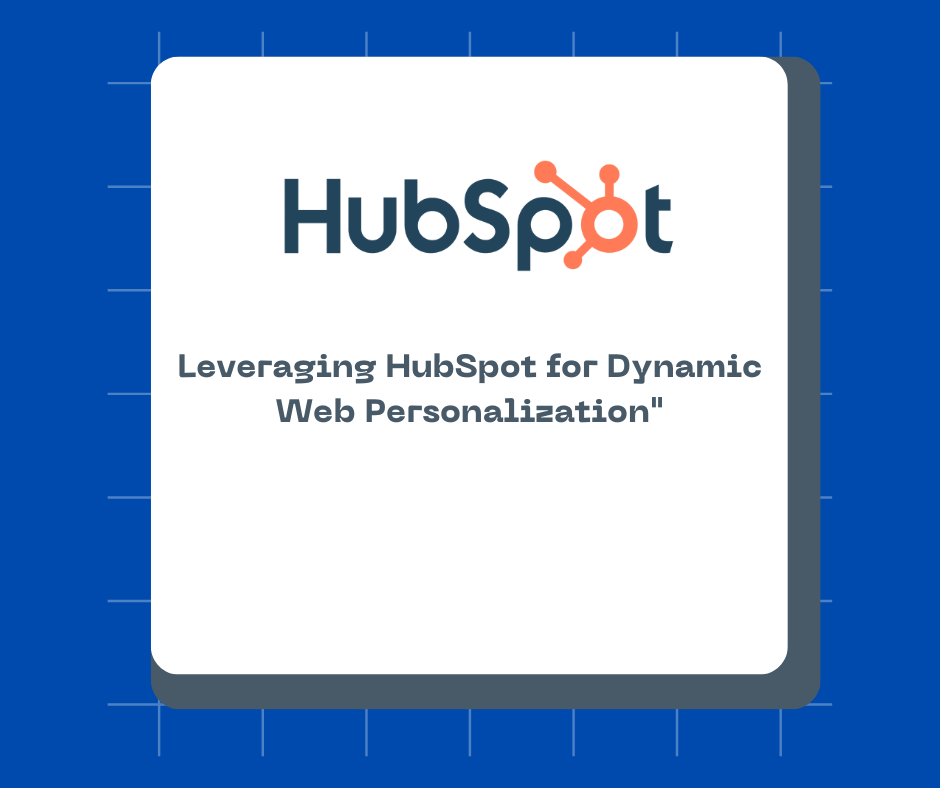In the fast-paced world of digital marketing, one-size-fits-all approaches are becoming increasingly obsolete. Today's consumers expect personalized experiences that cater to their individual preferences and needs. Dynamic web personalization is a powerful strategy that enables businesses to deliver tailored content and experiences to their website visitors based on factors such as demographics, behavior, and preferences. HubSpot, a leading CRM and marketing automation platform, offers robust features for implementing dynamic web personalization, allowing businesses to create engaging and relevant experiences that drive conversions and foster customer loyalty. In this article, we'll explore the concept of dynamic web personalization, the benefits it offers, and how businesses can leverage HubSpot to implement effective personalization strategies.
Understanding Dynamic Web Personalization:
Dynamic web personalization involves customizing website content and experiences in real-time based on visitor data and behavior. This approach allows businesses to deliver personalized content, product recommendations, and CTAs to each visitor, increasing engagement and conversion rates. Dynamic web personalization can be implemented using various techniques, such as content customization, product recommendations, and targeted messaging, to create a more personalized and relevant experience for website visitors.
The Benefits of Dynamic Web Personalization:
-
Improved User Experience: By tailoring content and experiences to individual preferences, dynamic web personalization enhances the overall user experience, making it more engaging and enjoyable for visitors.
-
Increased Engagement: Personalized content and recommendations capture the attention of visitors and encourage them to interact with the website, leading to higher engagement rates and longer time spent on site.
-
Higher Conversion Rates: Relevant and targeted content prompts visitors to take action, whether it's making a purchase, signing up for a newsletter, or filling out a form, resulting in higher conversion rates and improved ROI.
-
Enhanced Customer Loyalty: Personalized experiences foster a sense of connection and loyalty among customers, leading to repeat visits and increased brand advocacy.
Leveraging HubSpot for Dynamic Web Personalization:
HubSpot offers a range of features and tools that enable businesses to implement dynamic web personalization effectively. Here are some key ways businesses can leverage HubSpot for dynamic web personalization:
-
Smart Content: HubSpot's Smart Content feature allows businesses to customize website content based on visitor attributes such as location, device type, referral source, and more. By delivering relevant messaging and offers to each visitor, businesses can create a personalized experience that resonates with their audience.
-
Personalized CTAs: HubSpot enables businesses to create personalized calls-to-action (CTAs) that change dynamically based on visitor behavior and preferences. By displaying targeted CTAs that align with the visitor's interests and stage in the buyer's journey, businesses can encourage conversions and drive engagement.
-
Smart Lists: HubSpot's Smart Lists feature allows businesses to segment website visitors based on criteria such as demographics, behavior, and preferences. By creating dynamic lists of visitors with similar characteristics, businesses can deliver targeted content and offers that are tailored to each segment's needs.
-
A/B Testing: HubSpot's A/B testing capabilities enable businesses to experiment with different variations of website content and CTAs to determine which perform best. By testing and optimizing personalized content, businesses can continuously improve the effectiveness of their dynamic web personalization strategies.
-
Reporting and Analytics: HubSpot provides robust reporting and analytics tools that allow businesses to track the performance of their dynamic web personalization efforts. By monitoring key metrics such as engagement, conversion rates, and ROI, businesses can gain insights into the effectiveness of their personalization strategies and make data-driven decisions to optimize their campaigns.
Best Practices for Dynamic Web Personalization with HubSpot:
To maximize the impact of dynamic web personalization with HubSpot, businesses should follow these best practices:
-
Understand Your Audience: Take the time to understand your target audience's preferences, behaviors, and pain points to create personalized experiences that resonate with them.
-
Start Small: Begin by implementing simple personalization tactics, such as customizing CTAs or messaging based on visitor attributes, and gradually expand your personalization efforts as you gain insights and experience.
-
Test and Iterate: Experiment with different variations of personalized content and CTAs using HubSpot's A/B testing capabilities to identify what resonates most with your audience and optimize your campaigns accordingly.
-
Monitor Performance: Track the performance of your dynamic web personalization efforts using HubSpot's reporting and analytics tools, and use the data to refine your strategies and improve results over time.
-
Stay Compliant: Ensure that your personalization tactics comply with data privacy regulations such as GDPR and obtain consent from visitors before collecting or using their personal information.
Real-World Examples of Dynamic Web Personalization:
Many businesses have successfully implemented dynamic web personalization strategies using HubSpot. Here are a few real-world examples:
-
An e-commerce retailer uses HubSpot's Smart Content feature to display personalized product recommendations to visitors based on their browsing history and purchase behavior, leading to increased sales and customer satisfaction.
-
A software company leverages HubSpot's personalized CTAs to encourage visitors to sign up for a free trial of their product. By displaying targeted CTAs that address the visitor's pain points and interests, the company has seen higher conversion rates and improved lead generation.
-
A B2B company utilizes HubSpot's Smart Lists feature to segment website visitors based on their industry and job role. By delivering targeted content and offers to each segment, the company has been able to increase engagement and drive more qualified leads.
Conclusion:
Dynamic web personalization is a powerful strategy for creating personalized and engaging experiences that drive engagement, conversions, and customer loyalty. By leveraging HubSpot's features and tools, businesses can implement effective personalization tactics that resonate with their audience and deliver measurable results. Whether it's customizing website content, creating personalized CTAs, or segmenting visitors based on their preferences, HubSpot provides businesses with the tools they need to implement dynamic web personalization strategies that drive success. Embrace the power of dynamic web personalization with HubSpot and unlock new opportunities to connect with your audience and achieve your marketing goals.
Schedule your training session here and comment “Need Training” on the request form.

Comments